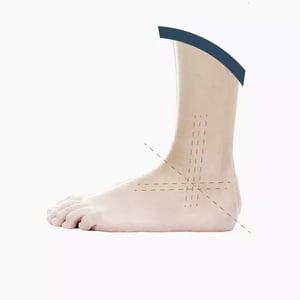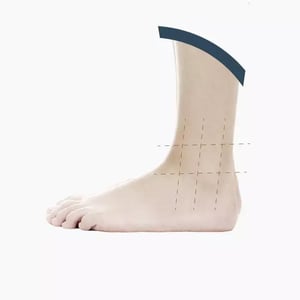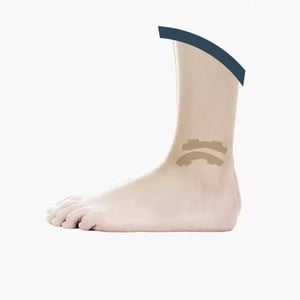Mobile-Bearing Ankle Prosthesis
Introduction
Today, however, particularly in the case of the ankle, prosthetic replacement has become a reliable and effective solution. This advancement is largely attributed to a concept—and the resulting European innovation—known as the mobile-bearing design.
Over the years, several implants have been developed based on this principle, which involves three fundamental components:
- a tibial component,
- a talar component,
- and a mobile polyethylene insert—referred to as the "meniscus"—from which the term "mobile-bearing" is derived.

In the image you can see the components of the mobile bearing ankle prosthesis (from top to bottom):
- Hintegra® “mobile bearing” complete ankle prosthesis;
- Hintegra® “mobile bearing” ankle prosthesis – talar component;
- Hintegra® “mobile bearing” ankle prosthesis – tibial component;
- Hintegra® “mobile bearing” ankle prosthesis – part
It is interesting to reflect on how this type of prosthetic design came to be.
The Evolution of Ankle Prosthesis

The first-generation ankle prostheses were essentially adapted from partial revisions of the geometry and tribology (the study of friction, lubrication, and material wear) of hip prostheses of that era. These early designs are still responsible for the deep skepticism that modern ankle replacements have had to overcome.
The main issue proved to be mid-term component loosening, largely due to an incomplete understanding of ankle anatomy in the designs of that time.
European research addressed this challenge in the late 1990s with the introduction of the mobile-bearing concept. Achieving this breakthrough required a focus on two key principles: "constraint" and "congruency"—that is, joint constraint and anatomical congruence—two opposing forces that must be carefully balanced.
In simple terms, a prosthetic implant must strike a balance between replicating the natural anatomy of the ankle (congruency) and providing the mechanical stability necessary for proper function (constraint).
The European solution—an ankle prosthesis (inserire link) with a mobile insert—significantly reduced the implant’s bulk, allowing for the preservation of bone tissue and enabling “press-fit” fixation to the skeleton, meaning no cementation is required.
Last but not least, this innovation has led to a key advantage: a longer lifespan of the implant.
Three fundamental characteristics make a mobile-bearing prosthesis reliable and effective—all of which are present in the Hintegra® implant that I use:
- Preservation of the anterior tibial cortex, which transmits more than 30% of the load borne by the tibia. In practical terms, this means avoiding fixation systems—such as rails—that run from front to back. The Hintegra® prosthesis addresses this by incorporating an anterior shelf, perpendicular to the articular surface, that rests securely on the tibia without requiring any disruption to the anterior cortex.
- A talar component shaped like a truncated cone, rather than a cylinder. This is anatomically accurate, as the natural talus has a medial diameter that is smaller than the lateral one. Reproducing this shape allows the patient to regain a more physiological gait.
- Restoration of correct alignment between the tibia and talus, ensuring biomechanical balance and functional stability.
These are the three key reasons why I have extensively used the Hintegra® prosthesis over the years—even in cases involving severe ankle deformities—without having to compromise my patients’ range of motion.
Preserving movement is particularly important because, unlike patients with hip or knee arthritis, those suffering from ankle arthritis are often younger and therefore have greater mobility demands in their daily lives.
Furthermore, as previously mentioned, these next-generation prostheses help reduce stress and degenerative changes in adjacent joints. This allows for better preservation of overall mobility—unlike arthrodesis (joint fusion), which often results in significant loss of motion.
Read our article: “Ankle prosthesis: 12 items of information for the patient“.
Mobile-Bearing. What has our Scientific Activity Brought That’s New?

Ankle replacement has traditionally been recommended for treating cases of ankle arthritis without associated deformities.
However, since most ankle arthritis is post-traumatic in nature, it is often accompanied by significant skeletal deformities. As a result, ankle replacement surgery was initially not considered suitable for patients with such deformities.
Our research and study of the ankle joint have led us to explore the possibility of using the prosthesis in conjunction with additional surgical procedures, such as subtalar arthrodesis.
One of our studies, published in the prestigious journal Foot and Ankle International, demonstrated the reproducibility of performing ankle replacement and subtalar arthrodesis in the same surgical procedure. This finding scientifically validated the use of the prosthetic implant even in patients with deformities of the back of the foot.
Subsequent research focused on the recovery times of patients who underwent mobile-bearing ankle prosthesis implantation, showing that full patient satisfaction was typically achieved within the first year after surgery.
We explained this process by observing a specific adaptive movement of the prosthesis, known as "posterior shifting" of the talus.
In one of our studies, we demonstrated the presence of a compensatory mechanism in the mobile-bearing prosthetic ankle, which becomes evident during the first six months after implantation.
This mechanism is linked to the function of the posterior musculature of the leg, particularly the triceps and flexor muscles, which helps explain the slightly longer recovery times associated with the mobile-bearing prosthesis compared to the fixed-bearing design.
However, in the field of prosthetic surgery, the speed of recovery is not the only critical factor.
On the contrary, the long-term survival of the implant is the ultimate goal, and this compensatory mechanism plays a crucial role in the durability of the mobile-bearing prosthesis.
Today, my first choice in the prosthetic field is the fixed-bearing resurfacing. However, in select cases, the mobile-bearing ankle prosthesis remains an important option that I still consider, and its effectiveness has been demonstrated not only by our research but also by the work of previous authors.
Scientific Publications:
- Identifying the learning curve for total ankle replacement using a mobile bearing prosthesis”
- (published in the European journal of Ankle and Foot Surgery: Foot and Ankle Surgery).
- “Pearls and Pitfalls for a Surgeon New to Ankle Replacements”
- (published on Foot and Ankle Clinics).
- Clinical Outcome and Fusion Rate Following Simultaneous Subtalar Fusion and Total Ankle Arthroplasty.
- Posterior Talar Shifting in Mobile-Bearing Total Ankle Replacement.
- Age-Related Outcome of Mobile-Bearing Total Ankle Replacement.
- Sagittal tibiotalar translation and clinical outcomes in mobile and fixed-bearing total ankle replacement.
- Sports and Recreational Activities following Total Ankle Replacement.
- Tibial slope in total ankle arthroplasty: Anterior or lateral approach.
- Infections in primary total ankle replacement: Anterior approach versus lateral transfibular approach.


